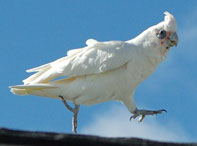As part of my first blog post, I thought I’d provide a bit more information about my background, why Learning Parrots is so important to me, and what you can expect from this blog. This organization was created not only to help people and parrots, but also as a necessary outlet for my insatiable fascination for all things behavior, particularly animal behavior. Living with animals provides a rich educational environment for us as caregivers. One of the most valuable (and mind-blowing!) ideas I ever heard was that the behavior we observe in our companions is a reflection on how we have trained them to behave; that is, animals are just doing what we have trained them to do, purposefully or not. It is our responsibility to teach them what is acceptable. Or, more precisely, what we want to see more of and what we don’t.
My name is Hillary Hankey, and I have been crazy about animals my entire life. As a kid, I carried around a collection of ZooBooks and Ranger Rick magazines read and re-read so many times the covers disintegrated into soggy illegible shreds. One summer day, I followed my cat around with my dad’s camcorder as an aspiring National Geographic researcher and collected what I called behavioral data on my wide-ruled “Hang in there” dangling kitten Trapper Keeper. In the sixth grade, I attempted to write my first book report on the Illustrated Encyclopedia of Animals before my teacher kindly pointed me in another direction (I think I settled on -big surprise- My Friend Flicka). My free time throughout childhood and early adulthood was spent taking care of my birds or at the barn, jumping horses and learning the intricacies of dressage.
Now, I am living the life I imagined in beautiful southern California, work at a zoo, and share my home with a pitbull, Bob, a giant schnauzer/lab mix, Stewie, two cats, Buzz and Dutch, nineteen snakes, a red-footed tortoise, Pajamas, and four fully-flighted cockatoos, Henry, a triton, Sailor, a slender-billed, Juice, a bare-eyed, and Sam, a moluccan. Beginning when I lived in Colorado as a college student, I trained them to fly free outdoors; nine years later, they are still freeflying almost every day. Working with their behavior through training sessions formal and informal is something I look forward to do every single day.
Life with animals is not always easy; in fact, most of the time they are incredibly demanding. My four cockatoos create a very dynamic environment as they interact with each other, my partner, Andre, and me. Their ability to learn and change their behavior based on their experiences is unparalleled in this household.
One summer day, I was at my computer with Sam, the moluccan. He was playing with some plastic water bottles I often use as foraging toys (my parrots are positively bananas about all things plastic and never ingest it!), so I put some of his favorite juice in one and filmed it to see what he would do.
As you can see, the big glug of juice down the throat was unpleasant enough for him to try a different tactic. But in doing so, he spilled the rest of the juice. I filled it again, moved the chair off the rug (I, too, learn from my experiences!), and filmed him again.
The subtlety of this experience hints to an exponentially larger learning capacity. All it took was one try for him to develop a better method. Behavior is a human or animal’s way of solving problems and achieving outcomes we value… as you can see, parrots are quite adept problem solvers. There is so much potential for harnessing that power to live a truly enriched life!
The power of a parrot to learn with such agility is unparalleled among our other companion animals, and perhaps one of the reasons we see problem behaviors arise and sustain is that we aren’t even aware of the nuances in the environment that maintain these behaviors. In this blog, you’ll find training notes, complete with successes and failures, as I continue to hone my own skills and adjust to their wide variety of needs. With four cockatoos, one of the most important aspects of their lives is keeping them busy with appropriate activities, so I am always sharing enrichment ideas and looking for more. I also spend much of my free time looking for simple ideas to incorporate positive reinforcement in to daily life to help build a coexistence based on empowerment, that is, giving my parrots choices and arranging the environment to make the right choices the easiest and most rewarding.
As a final note, while I am a huge advocate of flight and I do fly my own birds free outdoors, I do not coach people how to train their own birds for unrestrained outdoor freeflight. Such an activity requires at very least a professional advisor as well as careful analysis of the bird, the environment, and the trainer and the truth is, most birds in our homes are ill-prepared for the dangers inherent with freeflight.
Cheers!
hh

